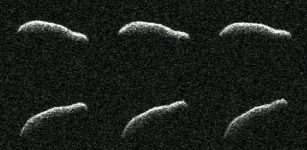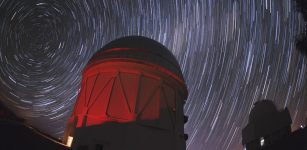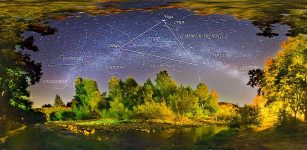Chinese Supernova 1181AD – 900-Year-Old Cosmic Mystery Solved
Eddie Gonzales Jr. – MessageToEagle.com – A 900-year-old cosmic mystery surrounding the origins of a famous supernova first spotted over China in 1181 AD has finally been solved, according to an international team of astronomers.
 Credit: University of Manchester
Credit: University of Manchester
New research says that a faint, fast-expanding cloud (or nebula), called Pa30, surrounding one of the hottest stars in the Milky Way, known as Parker’s Star, fits the profile, location, and age of the historic supernova.
There have only been five bright supernovae in the Milky Way in the last millennium (starting in 1006). Of these, the Chinese supernova, which is also known as the “Chinese Guest Star” of 1181 AD has remained a mystery. It was originally seen and documented by Chinese and Japanese astronomers in the 12th century who said it was as bright as the planet Saturn and remained visible for six months.
They also recorded an approximate location in the sky of the sighting, but no confirmed remnant of the explosion has even been identified by modern astronomers. The other four supernovae are all now well known to modern-day science and include the famous Crab nebula.
The source of this 12th-century explosion remained a mystery until this latest discovery was made by a team of international astronomers from Hong Kong, the UK, Spain, Hungary, and France, including Professor Albert Zijlstra from The University of Manchester. In the new paper, the astronomers found that the Pa 30 nebula is expanding at an extreme velocity of more than 1,100 km per second (at this speed, traveling from the Earth to the moon would take only five minutes).
They use this velocity to derive an age at around 1,000 years, which would coincide with the events of 1181 AD.
Prof Zijlstra (Professor in Astrophysics at the University of Manchester) explains: “The historical reports place the guest star between two Chinese constellations, Chuanshe and Huagai. Parker’s Star fits the position well. That means both the age and location fit with the events of 1181.”
Pa 30 and Parker’s Star have previously been proposed as the result of a merger of two White Dwarfs. Such events are thought to lead to a rare and relatively faint type of supernova, called a Type Iax supernova.
Prof Zijlstra added: “Only around 10% of supernovae are of this type and they are not well understood. The fact that SN1181 was faint but faded very slowly fits this type. It is the only such event where we can study both the remnant nebula and the merged star, and also have a description of the explosion itself.”
The merging of remnant stars, white dwarfs, and neutron stars, give rise to extreme nuclear reactions and form heavy, highly neutron-rich elements such as gold and platinum.
Prof. Zijlstra said: “Combining all this information such as the age, location, event brightness and historically recorded 185-day duration, indicates that Parker’s star and Pa30 are the counterparts of SN 1181.
This is the only Type Iax supernova where detailed studies of the remnant star and nebula are possible. It is nice to be able to solve both a historical and an astronomical mystery.
Written by Eddie Gonzales Jr. MessageToEagle.com Staff
Related Posts
-
 Wandering Massive Black Holes In Dwarf Galaxies Are Not At The Centers Of Their Galaxies
No Comments | Jan 14, 2020
Wandering Massive Black Holes In Dwarf Galaxies Are Not At The Centers Of Their Galaxies
No Comments | Jan 14, 2020 -
 Detailed View Of Oblong Asteroid – Captured By NASA’s Planetary Radar
No Comments | Feb 19, 2023
Detailed View Of Oblong Asteroid – Captured By NASA’s Planetary Radar
No Comments | Feb 19, 2023 -
 Giant Doubts About Giant Exomoons
No Comments | Dec 11, 2023
Giant Doubts About Giant Exomoons
No Comments | Dec 11, 2023 -
 Ancient Stars Found In Milky Way’s Stellar Thin Disk
No Comments | Aug 1, 2024
Ancient Stars Found In Milky Way’s Stellar Thin Disk
No Comments | Aug 1, 2024 -
 Peering Into The Moon’s Shadows
No Comments | Sep 24, 2021
Peering Into The Moon’s Shadows
No Comments | Sep 24, 2021 -
 Hubble Constant: Cosmologists Provide New Measurement Of Cosmic Controversy
No Comments | Nov 14, 2018
Hubble Constant: Cosmologists Provide New Measurement Of Cosmic Controversy
No Comments | Nov 14, 2018 -
 Galactic Fireworks: Beautiful New ESO Images Of Five Nearby Galaxies
No Comments | Jul 19, 2021
Galactic Fireworks: Beautiful New ESO Images Of Five Nearby Galaxies
No Comments | Jul 19, 2021 -
 Collision Between Two Milky Way Satellite Galaxies – Confirmed
No Comments | Oct 26, 2018
Collision Between Two Milky Way Satellite Galaxies – Confirmed
No Comments | Oct 26, 2018 -
 ‘Black Hole Police’ Discover A Dormant Black Hole Outside The Milky Way Galaxy
No Comments | Jul 19, 2022
‘Black Hole Police’ Discover A Dormant Black Hole Outside The Milky Way Galaxy
No Comments | Jul 19, 2022 -
 Vega – An Old Astronomical Touchstone In The Sky
No Comments | Dec 12, 2012
Vega – An Old Astronomical Touchstone In The Sky
No Comments | Dec 12, 2012
